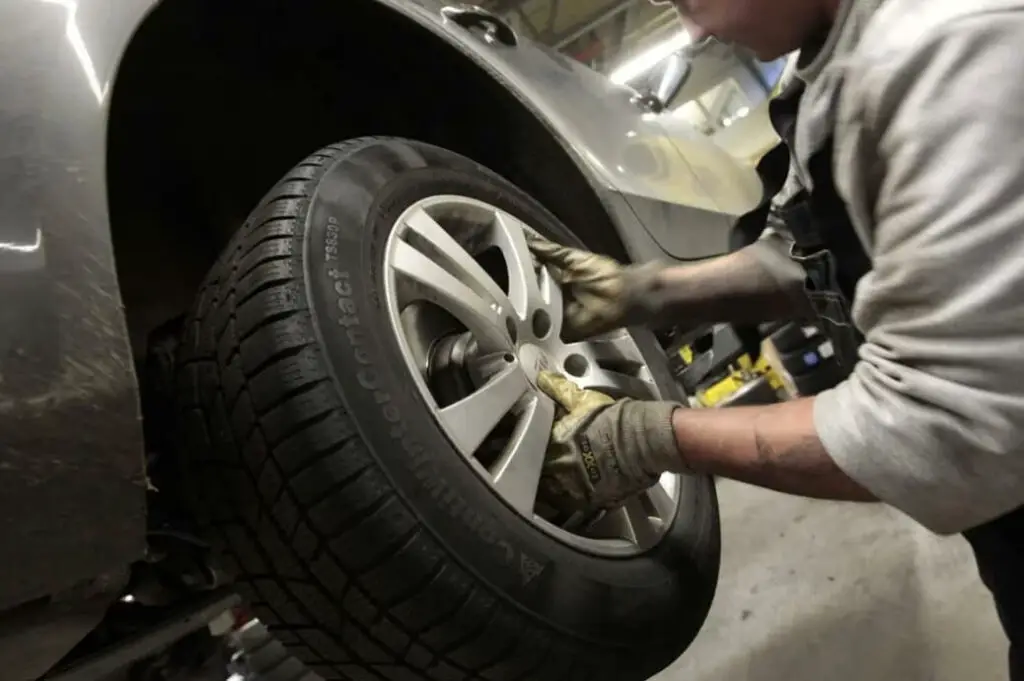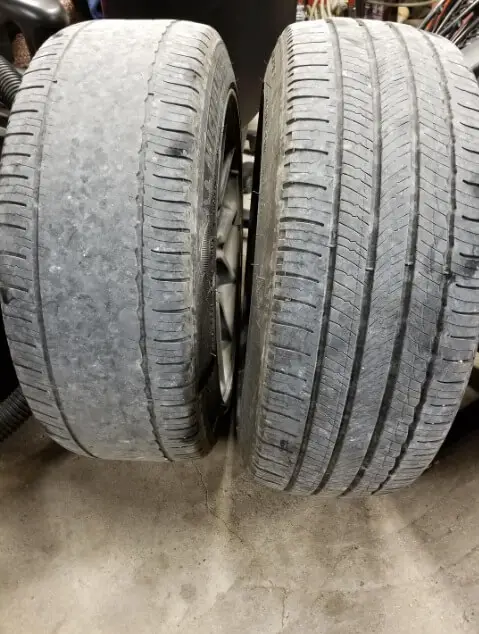Are tire rotations necessary? What happens if you don’t rotate your tires? Many drivers ask these questions, neglecting these crucial aspects of car maintenance. This guide aims to shed light on the consequences that await. Through real-life examples and expert advice, we’ll explore the impact of overlooking tire rotation. Let’s dive into the unknown, unravel the truth, and ensure a safer, smoother drive for you.
Neglecting tire rotation can have dangerous consequences. Uneven wear can lead to reduced traction and increased risk of accidents. Plus, it can affect fuel efficiency and tire lifespan.
Weight distribution, alignment and driving habits cause tires to wear unevenly. Not rotating them regularly can make this pattern more pronounced, resulting in tires wearing out faster and reducing their ability to grip the road.

Failing to rotate tires also creates drag on the vehicle’s motion due to uneven wear. This extra resistance requires more power from the engine, leading to higher fuel costs.
Regular tire rotation can extend their lifespan. Tires that wear evenly have better performance and a longer tread depth. On the contrary, not rotating tires can cause premature wear and costly replacements.
Importance of Tire Rotation
Tire rotation is an important part of tire maintenance. Not rotating your tires can affect your vehicle’s performance and safety. It’s essential to know why tire rotation is so important.
- Uniform Tire Wear: Rotating your tires helps them wear down evenly. This prevents early wear, which can cause bad handling and decreased traction.
- Extended Tire Lifespan: Tire rotation helps them last longer. Uneven wear can decrease their longevity, needing replacement sooner.
- Better Fuel Efficiency: Evenly worn tires reduce resistance. This allows for more efficient movement, better gas mileage.
- Enhanced Vehicle Performance: Rotating tires ensures they work together. This promotes stability, smoother rides, improved handling, and braking.
It’s also worth noting that rotation intervals depend on vehicle make/model, driving style, and road conditions. During WWII, the US military faced uneven tire wear. To fix this, they pioneered regularly switching wheels between positions. This became known as tire rotation – something still used today.
By understanding the importance of tire rotation, we can maximize tire lifespan, improve vehicle performance, and ensure safer driving. Rotating tires is not optional – it is necessary for optimal tire condition and road safety.
Must check: Does Discount Tire Rotate Tires for Free? Your Ultimate Guide
Effects of Not Rotating Tires
Omitting to rotate your tires can have bad effects on their performance and lifespan. No upkeep can lead to unequal wear, less traction, decreased fuel efficiency, and potential security dangers.
Neglecting tire rotation not just hinders their performance but also reduces their lifespan. Without regular rotation, some tires bear a greater weight and experience more strain than the rest. Ultimately, this speeds up tire wear and requires early replacements.
If you don’t rotate your tires, uneven wear occurs, leading to reduced tire lifespan, compromised handling, and potential suspension issues. Regular tire rotation ensures balanced wear, promoting optimal performance, safety, and longevity. Without it, you risk facing traction problems, unexpected tire failures, and strain on vehicle components. To maximize tire benefits and avoid these pitfalls, tire rotation should be part of routine vehicle maintenance.

In reality, CarCare states that not rotating tires can cause tire life to be cut by up to 20%. Thus, it is vital to make this easy yet essential maintenance task a priority to guarantee optimal tire performance and endurance.
Must check: How to Rotate Tires with One Jack: A Must-Know Skill for Car Owners
Step-by-Step Guide to Tire Rotation
Tire rotation is a must! It can extend your tire’s life and improve vehicle performance. Even wear, better traction, and improved fuel efficiency – it all comes from regular tire rotation. Here’s how to do it:
- Step 1: Inspect tires for damage or wear – Look for bulges, cracks, or uneven wear. If you notice any issues, address them first.
- Step 2: Choose the right rotation pattern – Forward cross, rearward cross, X-pattern, side-to-side… Consult your manual or seek help from a pro for the best pattern.
- Step 3: Lift and remove tires – Use a jack or hydraulic lift to raise each corner of the vehicle. Then loosen the lug nuts with a wrench.
- Step 4: Install and tighten tires – Reinstall each tire in its new position. Align the wheels, hand-tighten, then lower the vehicle. Finally, use a torque wrench to finish tightening.
Tire rotation promotes even tread wear, maintains alignment and balance. It prevents strain on specific tires and extends tire life by changing their positions.
To get the most out of tire rotation: rotate every 5-7,500 miles or as advised by your manufacturer. Consider an alignment too. Check air pressure regularly.
Do all this and you’ll be safe on the road and save money. Tire rotation is a simple but important maintenance task – don’t ignore it!
Must check: Do Trailer Tires Need to Be Balanced? Expert Advice Revealed
Frequency and Recommendations for Tire Rotation
Tire rotation is a must for keeping your tires’ performance and lifespan. Ignoring this may lead to issues with your vehicle’s handling, fuel usage, and safety. To guarantee the best tire rotation, follow these tips:
- Frequency: It’s recommended to rotate your tires every 5,000 – 8,000 miles or as stated in the manufacturer’s instructions. This will help spread the wear evenly.
- Tire Position: Rotate your tires in the pattern shown by the vehicle manufacturer. It can be front-to-back or crisscross. This makes sure the wear is equal, both at the front and rear, and on both sides of the car.
- Spare Tire: If your vehicle has a spare tire same size and type as the other four, include it in the process to ensure even wear for all five tires.
- Tread Inspection: When rotating the tires, check the tread depth and condition. Uneven wear might mean alignment or mechanical issues that must be taken care of right away.
- Balance & Alignment: Make sure to balance and align your tires regularly. Balancing ensures smooth driving and alignment stops uneven tread wear.
- Professional Assistance: If you’re uncertain how to rotate the tires correctly or don’t have the necessary tools, seek help from a reliable auto service center.
Refer to your vehicle’s manual for specific instructions related to its make and model.
Following these tire rotation practices will ensure optimal performance, extend their life, and improve your driving experience.
Pro Tip: Tire rotation isn’t just for even wear. It also boosts traction and stability. Don’t miss out on this simple job!
FAQs on What Happens if You Don’t Rotate Your Tires:
Tire rotation is a key component of vehicle maintenance, and many drivers wonder about its necessity and implications. What does tire rotation do for the longevity and performance of your tires? How often should you rotate them? And, importantly, what are the consequences of not rotating tires?
This FAQ section delves into these pressing questions, helping vehicle owners understand the critical signs that indicate a need for tire rotation and the potential pitfalls of neglecting this essential practice. Here we go:
-
How often should you rotate your tires?
It is generally recommended to rotate your tires every 5,000 to 8,000 miles, or every six months, whichever comes first. However, you should check your vehicle’s owner’s manual for the manufacturer’s specific recommendations.
-
Can I rotate my tires myself?
Yes, tire rotation can be done at home if you have the necessary tools and knowledge. However, it is recommended to have it done by a professional at a service center to ensure it is done correctly.
-
What happens if you don’t rotate your tires?
If you don’t rotate your tires regularly, they will wear unevenly. This can result in reduced traction, poor handling, and an increased risk of accidents.
-
What are the benefits of tire rotation?
Tire rotation helps promote even wear on your tires, which extends their lifespan. It also improves traction, enhances fuel efficiency, and maintains optimal performance and safety of your vehicle.
-
What happens if I ignore tire rotation?
If you ignore tire rotation, the tires will wear unevenly, causing some to become bald sooner than others. This can result in a bumpy and uncomfortable ride, decreased fuel efficiency, and the need for premature tire replacement.
-
Does tire rotation affect the warranty?
No, tire rotation does not affect your vehicle’s warranty. In fact, it is often recommended by manufacturers to maintain warranty coverage as it is considered regular maintenance for optimal tire performance.
-
Can not rotating tires cause vibration?
Yes, not rotating tires can indeed lead to uneven tire wear. This uneven wear can manifest as an imbalance in the tires, which in turn can cause vibrations felt in the steering wheel, seat, or floorboard, especially at high speeds. If left unaddressed, these vibrations can not only be uncomfortable for the driver and passengers but can also lead to additional strain on vehicle components, reducing their lifespan and compromising safety.
-
What happens if you don’t rotate your tires with an all-wheel drive vehicle?
For all-wheel drive (AWD) vehicles, tire rotation is pivotal. Failing to rotate tires in an AWD can lead to uneven wear patterns. Uneven wear affects the vehicle’s handling, traction, and efficiency. Moreover, significant tread discrepancies can strain the drivetrain because AWD systems rely on consistent traction from all four tires. Over time, this can result in premature wear of the drivetrain components, leading to expensive repairs.
Conclusion: The Consequences of Not Rotating Your Tires
Tire rotation, often overlooked, plays an integral role in maintaining your vehicle’s performance and safety. Regular tire rotation ensures even wear, aiding in the extension of your tire’s lifespan and maintaining optimal traction.
Over time, not rotating tires leads to uneven wear, compromising stability and grip, particularly crucial in adverse driving conditions. This imbalance can even be the precursor to unexpected tire failures or blowouts. Furthermore, the suspension system relies on even tire wear to function properly.
If you don’t rotate your tires, you risk uneven wear, reduced tire lifespan, compromised vehicle handling, and potential suspension issues. Regular rotation aids in maximizing tire performance, longevity, and safety.
How often should you rotate your tires? Generally, every 5,000 to 8,000 miles, though it may vary based on the vehicle and tire type. But what happens when you don’t rotate your tires? Aside from the uneven wear and potential hazards, skipping this vital maintenance can reduce the overall lifespan of your tires by up to 20%.
One of the signs you need a tire rotation is when you notice differences in tread depth across tires or vibration at high speeds. And while many wonder about the costs, it’s essential to understand that the expense of not rotating tires, in the long run, can be much higher than the minimal cost of a regular tire rotation.
So, next time you ponder whether tire rotation is necessary, remember its role in ensuring a safer, smoother drive.
Don’t miss out on these related topics: